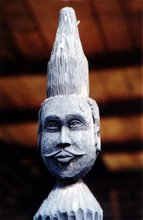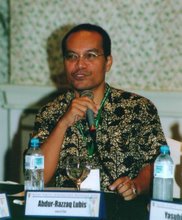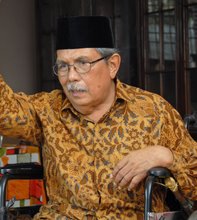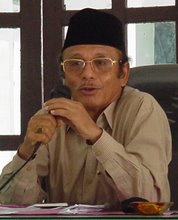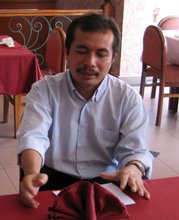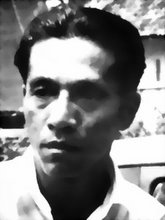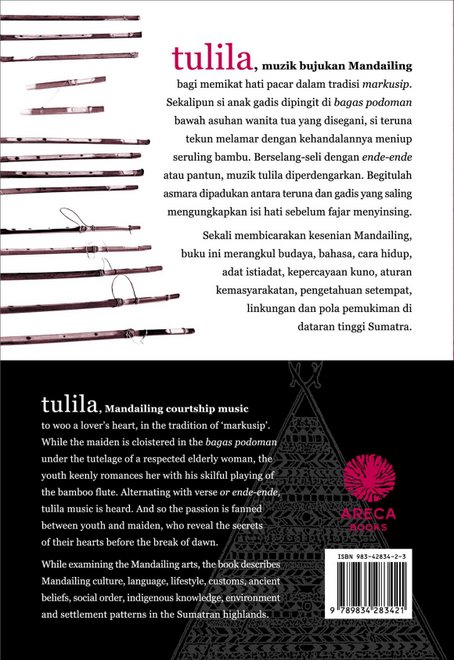
The Star, Sunday October 3, 2004
Private letters, public concerns
Review by LEONARD Y. ANDAYA
RAJA BILAH AND THE MANDAILINGS IN PERAK: 1875-1911
By Abdur-Razzaq Lubis and Khoo Salma NasutionPublisher: Malaysian Branch of the Royal Asiatic Society, 278 pages
ALTHOUGH the title of this book suggests a very specific micro-history of one of the ethnic groups in Malaysia, the contents provide an unexpectedly rich and interesting account of an important period in Malay history seen from the local level. The initial impetus for this study was the discovery of the “Penghulu Papers”, which contains the personal correspondence of three generations of a prominent Mandailing family in Selangor and Perak between 1875 and 1911.
The story begins with Raja Asal, who emigrated from Sumatra to escape the Padri Wars in the early decades of the 19th century. But the bulk of the narrative concerns his nephew, Raja Bilah, who was a leader of the Mandailings in Perak. Raja Bilah was appointed penghulu; thus, his correspondence included letters with well-known British administrators and Chinese leaders, as well as ordinary people.
The preservation of a private family’s correspondence over such a long period is in itself a rarity in the history of the region. Equally important is the fact that the Penghulu Papers brings to life a period known in Malaysian history as the British “Forward Movement”. The serendipitous coincidence of the time frame of the Penghulu Papers and the British colonisation of the Malay Peninsula makes the papers a particularly valuable complement to the official version of the history then.
Rupert Emerson, C.D. Cowan, Emily Sadka, Eunice Thio, Chai Hon Chan and others have provided a detailed study of the colonial administrative structure, which include descriptions of the functions of the Malay penghulu. In this book, Abdur-Razzaq Lubis and Khoo Salma Nasution have skilfully culled those letters which deal with various aspects of a penghulu’s life. Even though they are interested in the Mandailing as a specific ethnic group, the activities of Raja Bilah as their penghulu in Lower Perak are very likely representative of other penghulu in the late 19th and early 20th centuries.
Raja Bilah dealt with matters of land claims, illnesses and diseases, relations with the Chinese mining community, Islam and wars. Not only was he part of a larger administrative structure, but he was also the leader of customary practices and was consulted in matters dealing with debt, marriage, the pilgrimage, and many other personal matters that required advice from a wise elder of the group. The correspondence provides a rare glimpse of the life of the ordinary Malays, Chinese, and what the British termed the “foreign Malays” (which included the Mandailing) during this important transitional period in the history of the Malay Peninsula.
The authors have succeeded in combining a number of sources to produce this study. The Colonial Record Office files on microfilm in Kuala Lumpur provided some of the detail not already covered by previous scholars. Khoo and Abdur-Razzaq have judiciously combined Indonesian sources written by Mandailing scholars with the more accessible articles and books in English to offer a Mandailing cultural explanation for some of their practices in their new homeland.
They argue, for example, that Mandailing irrigation techniques applied in the Kinta area in Perak enabled the community to produce a surplus of rice to feed the ever-growing Chinese mining population. The techniques learned in the gold mines in Sumatra were also applied successfully in the tin mines in Perak. In discussing these techniques they cited two French mining engineers and reproduced the sketches which were made in the late 19th century.
There is much of interest in this book, including wonderful reproductions of old photographs and of more recent ones taken by Khoo. These illustrations help bring to life many of the comments made in the Penghulu Papers. Khoo’s interest in preservation is apparent in her nostalgic photographs of the now decrepit old Mandailing houses and of a mosque which has the old tiered roofs instead of the Mughal-style bulbous domes. Old photographs of the Mandailing families provide a wonderful pictorial history of this ethnic group in Malaysia and demonstrates the possibilities of using photographs in the reconstruction of the country’s more recent past.
The authors have also used a source called the “Riwayat Tuan Abu Bakar”, about the experiences of a young Mandailing who was born in Kuala Lumpur and died sometime in the 1950s. He travelled throughout the peninsula and wrote of his experiences with the Mandailing communities he encountered, and supplemented his comments with some simple but interesting sketches of his travels. This 829-page Jawi manuscript was transliterated into Rumi, with the help of the Toyota Foundation, but it remains a text waiting to be studied.
As a professional historian, I would have liked to see a consolidation of the sections and a far more comprehensive index with entries for mining techniques, relations with colonial administrators, Chinese, Orang Laut, and Mandailing cultural practices. This book provides not only a detailed and interesting historical account of the Mandailing community, but also a rare indigenous viewpoint of events during the extension of British colonial rule in the Malay Peninsula in the late 19th and early 20th centuries. One hopes that other family letters will come to light to provide scholars with the opportunity to piece together more on the lives of the ordinary people in the making of this country.
Dr Leonard Y. Andaya is Professor of South-East Asian History, Department of History, University of Hawaii.
Private letters, public concerns
Review by LEONARD Y. ANDAYA
RAJA BILAH AND THE MANDAILINGS IN PERAK: 1875-1911
By Abdur-Razzaq Lubis and Khoo Salma NasutionPublisher: Malaysian Branch of the Royal Asiatic Society, 278 pages
ALTHOUGH the title of this book suggests a very specific micro-history of one of the ethnic groups in Malaysia, the contents provide an unexpectedly rich and interesting account of an important period in Malay history seen from the local level. The initial impetus for this study was the discovery of the “Penghulu Papers”, which contains the personal correspondence of three generations of a prominent Mandailing family in Selangor and Perak between 1875 and 1911.
The story begins with Raja Asal, who emigrated from Sumatra to escape the Padri Wars in the early decades of the 19th century. But the bulk of the narrative concerns his nephew, Raja Bilah, who was a leader of the Mandailings in Perak. Raja Bilah was appointed penghulu; thus, his correspondence included letters with well-known British administrators and Chinese leaders, as well as ordinary people.
The preservation of a private family’s correspondence over such a long period is in itself a rarity in the history of the region. Equally important is the fact that the Penghulu Papers brings to life a period known in Malaysian history as the British “Forward Movement”. The serendipitous coincidence of the time frame of the Penghulu Papers and the British colonisation of the Malay Peninsula makes the papers a particularly valuable complement to the official version of the history then.
Rupert Emerson, C.D. Cowan, Emily Sadka, Eunice Thio, Chai Hon Chan and others have provided a detailed study of the colonial administrative structure, which include descriptions of the functions of the Malay penghulu. In this book, Abdur-Razzaq Lubis and Khoo Salma Nasution have skilfully culled those letters which deal with various aspects of a penghulu’s life. Even though they are interested in the Mandailing as a specific ethnic group, the activities of Raja Bilah as their penghulu in Lower Perak are very likely representative of other penghulu in the late 19th and early 20th centuries.
Raja Bilah dealt with matters of land claims, illnesses and diseases, relations with the Chinese mining community, Islam and wars. Not only was he part of a larger administrative structure, but he was also the leader of customary practices and was consulted in matters dealing with debt, marriage, the pilgrimage, and many other personal matters that required advice from a wise elder of the group. The correspondence provides a rare glimpse of the life of the ordinary Malays, Chinese, and what the British termed the “foreign Malays” (which included the Mandailing) during this important transitional period in the history of the Malay Peninsula.
The authors have succeeded in combining a number of sources to produce this study. The Colonial Record Office files on microfilm in Kuala Lumpur provided some of the detail not already covered by previous scholars. Khoo and Abdur-Razzaq have judiciously combined Indonesian sources written by Mandailing scholars with the more accessible articles and books in English to offer a Mandailing cultural explanation for some of their practices in their new homeland.
They argue, for example, that Mandailing irrigation techniques applied in the Kinta area in Perak enabled the community to produce a surplus of rice to feed the ever-growing Chinese mining population. The techniques learned in the gold mines in Sumatra were also applied successfully in the tin mines in Perak. In discussing these techniques they cited two French mining engineers and reproduced the sketches which were made in the late 19th century.
There is much of interest in this book, including wonderful reproductions of old photographs and of more recent ones taken by Khoo. These illustrations help bring to life many of the comments made in the Penghulu Papers. Khoo’s interest in preservation is apparent in her nostalgic photographs of the now decrepit old Mandailing houses and of a mosque which has the old tiered roofs instead of the Mughal-style bulbous domes. Old photographs of the Mandailing families provide a wonderful pictorial history of this ethnic group in Malaysia and demonstrates the possibilities of using photographs in the reconstruction of the country’s more recent past.
The authors have also used a source called the “Riwayat Tuan Abu Bakar”, about the experiences of a young Mandailing who was born in Kuala Lumpur and died sometime in the 1950s. He travelled throughout the peninsula and wrote of his experiences with the Mandailing communities he encountered, and supplemented his comments with some simple but interesting sketches of his travels. This 829-page Jawi manuscript was transliterated into Rumi, with the help of the Toyota Foundation, but it remains a text waiting to be studied.
As a professional historian, I would have liked to see a consolidation of the sections and a far more comprehensive index with entries for mining techniques, relations with colonial administrators, Chinese, Orang Laut, and Mandailing cultural practices. This book provides not only a detailed and interesting historical account of the Mandailing community, but also a rare indigenous viewpoint of events during the extension of British colonial rule in the Malay Peninsula in the late 19th and early 20th centuries. One hopes that other family letters will come to light to provide scholars with the opportunity to piece together more on the lives of the ordinary people in the making of this country.
Dr Leonard Y. Andaya is Professor of South-East Asian History, Department of History, University of Hawaii.
